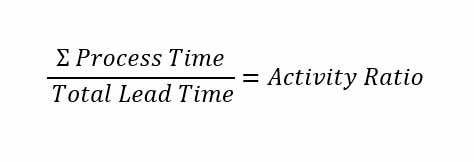Activity Ratio
The activity ratio is a measure of how quickly work moves through a process. It is simply the sum of the process times divided by the total lead time.

For example, if the processing time was 30 minutes and the lead time was 2 hours, the activity ratio would be .25 or 25%.

The activity ratio is a good gauge of how much time work is sitting idle in a value stream. As a result, it is a solid measure of flow. The higher the ratio, the better the flow.
The drawbacks to using the activity ratio as an indicator is that there is no measure of value—the process step may not be adding to the finished product. There also might be a lot of waste in the process.
Still, despite these drawbacks, work sitting idle is often an indicator of broader problems. The steps you’d take to speed up the flow of that work are often the same steps you would take to pull waste out of a process. For that reason, I recommend considering using the activity ratio as an improvement metric in processes with a lot of piles of work between steps.

Words of Warning
- Watch for your units—a common error is to mix seconds and minutes.
- 2:36 is not the same as 2.36. Dividing times can be tricky. You’ll need to divide 36/60 to get the proper fraction.
- Don’t use 24 hours as a day. Your lead time should only consider the time that a factory is running. Activity ratio is an efficiency metric, not a delivery metric.
- You’ll need to multiply the decimal result by 100 to get a percentage.
- Cycle time will never be higher than lead time. Lead time includes both cycle time and the time the parts sit in piles. If a product is worked on continuously, the activity ratio will be 100%.
- The term ‘activity ratio’ is also used in accounting to describe several financial ratios. Don’t let that duplicate use of the term confuse you.


2 Comments
Uju · December 30, 2020 at 8:59 am
Please can you simplified the mathematics
How did you get .25
Jeff Hajek · December 30, 2020 at 9:31 am
Process time is 30 and the total lead time would be 2 hours or 120 minutes. So it would be 30/120. The important point to note here is that I am assuming total lead time which would actually include the processing time. So it might sit for 30 minutes, get worked on for a few, sit for a few, get a little more work done on it, etc. The total lead time would be from the start point to the end point, regardless of what is happening to the item.